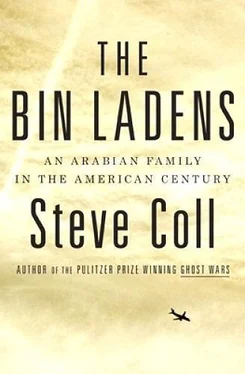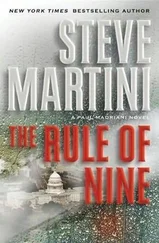The real powers in southern Doan at the time of Awadh’s arrival were not the British or the Mukalla sultans, but a family of local sheikhs called the Ba Surras, who ruled from a mud-brick castle named Masna’a. The Ba Surra governor at the time Awadh Bin Laden arrived took ten wives during his lifetime and suffered from blindness. He ruled the canyon with a firm hand. “Murder cases are now practically non-existent,” a British agent reported with satisfaction to London. “Murderers are executed with a dagger plunged into the supra sternal notch.” 8
Doan had about twenty thousand inhabitants, by the Ba Surras’ count. They were succored by nearly two hundred mosques, but only two small schools, in which the curriculum was the Koran. None of the women the English traveler Freya Stark met during the early 1930s could read. Palm trees from the riverbed were harvested for profit, and a few wealthier traders kept bees on their terraces, extracting an export crop of aromatic honey known as an aphrodisiac, particularly if eaten with meat, “something that only men may do, as it is thought inadvisable to excite women too much,” the traveler Doreen Ingrams noted. 9
Awadh Bin Laden chose Doan as a sanctuary from the Obeidis because it enjoyed a reputation for peace and order under the Ba Surras that was then rare in the Hadhramawt, according to some of Awadh’s descendants. He settled a few miles from the Ba Surra fortress, in Rabat Bashan, a town stacked up against Doan’s southernmost wall, surrounded by palms on the valley floor. Eight hundred men owning one hundred rifles lived there, according to the British survey conducted in the early 1930s. Awadh seems to have had few firm connections when he first arrived in Doan; he relied instead on the region’s reputation for hospitality, and his own willingness to work. The evidence about Awadh’s circumstances after his arrival in Rabat is sketchy, as he was now separated from the family group in Rakiyah that has kept what oral history survives. He is said to have worked as a wage laborer on local small farms. He did well enough to marry a woman in the town; she was from the Al-Madudi family. 10
Awadh and his wife had three daughters and three sons. The boys were Mohamed, Abdullah, and Omar; the latter died in childhood, a common fate. (The names of the daughters are not recalled; in Arabia then, as now, the stories of a family’s women were rarely told.) The year of Mohamed’s birth is sometimes given as 1908, an approximation at best; the celebration of birthdays is not an Arabian tradition, and there was barely a government in Doan then, never mind a birth registry. 11
Once he settled into his Rabat exile, Awadh Bin Laden worked hard and died young. Indeed, he seems to have died before his two surviving sons, Mohamed and Abdullah, had reached adolescence. 12
As was true elsewhere in the Hadhramawt, Doan’s economy relied upon the persistent willingness of local boys and young men to sail away to foreign jobs, work for years at a time in difficult conditions, and remit money home. Some left at very early ages, as young as six or seven years old. It was also common for local men to marry in their teens, emigrate to Ethiopia or Somalia or Egypt, and stay away for as long as two decades, taking other wives while abroad. For most young men in Doan the question was not whether to leave, but where to go. They depended upon informal employment networks sponsored by Hadhrami traders who had business interests in particular ports abroad. The loyalty of one Hadhrami stranger to another was extraordinary, and by the early twentieth century this ethic had created a thriving diaspora from the Levant to Southeast Asia. In one letter discovered from the early twentieth century, a father writes instructions to two of his young boys about how they should make their way from Hadhramawt to Singapore—he provides lists of trusted contacts in four different port cities and urges the boys to send many postcards home. Young men from the northern Hadhramawt valleys generally emigrated through these kin networks to Southeast Asia; from Doan, they went primarily to Africa or up the Red Sea coastline.
Emigration would have seemed a natural choice for fatherless Mohamed and Abdullah Bin Laden. As they considered their destinations they were probably advised by their mother’s family and by other townspeople concerned about their welfare, now that Awadh was gone. The richest man in Rabat was a descendant of the Prophet Mohamed named Sayyid Muhammed Ibn Iasin, a Red Sea cotton dealer with a “long face and large pleasant mouth” whose household kept bees and Ethiopian slaves. 13The Iasins had connections in Massawa, the main Eritrean port. Another prominent family in the canyon, who lived about a mile or two away, had relatives in Addis Ababa, and had made a small fortune trading skins there. It was likely through one of these contacts that Mohamed Bin Laden, the eldest of Awadh’s sons, but a boy of less than twelve years old, first climbed the canyon walls and joined the camel caravans for the walk to the port of Mukalla.
He sailed to Africa, survived the voyage, and found work somewhere in Ethiopia. But his journey ended in disaster. The Bin Laden family’s oral history contains at least two versions about what happened to him. In one, Mohamed was working as a sweeper in a store or small business. According to what his brother Abdullah later told the family, his boss was a disagreeable man with a fierce temper who kept a ring of keys fastened to his belt; one day, annoyed at Mohamed, he hurled the keys at the boy and struck him in the face. The injury was so severe that Mohamed lost his eye. A second version, told by some of the Bin Ladens who remained in Yemen, holds that Mohamed was working on an Ethiopian building site when an iron bar dropped accidentally from a high building, hit the ground, bounced up, and struck his eye. In any event, Mohamed Bin Laden would grow into adulthood with a right eye made of glass. 14
Mohamed returned to Doan after his injury. A massive earthquake destroyed the Abyssinian port of Massawa in 1921, devastating the region’s economy; this may also have been a factor in his retreat. Townspeople in Rabat say it was 1925 when Mohamed left again. This time he traveled with his younger brother Abdullah. It would be about twenty-five years before the brothers returned. Their mother later died in Doan, according to Bin Laden family members who stayed in Yemen; it seems doubtful that the boys ever saw her again.
They aimed now for the eastern coast of the Red Sea. In the port of Jeddah, the gateway favored by Muslim pilgrims traveling to the holy city of Mecca, there was a sizable community of Hadhrami merchants and laborers, including some from Doan; other Hadhramis resided in Mecca itself.
At the time the Bin Laden boys embarked on this journey, Abdullah was only about nine or ten years old; Mohamed was perhaps fourteen or fifteen, according to what Abdullah later related to his family. The journey Abdullah remembered was inflected by magic, miracles, and religious portents. They found their way aboard the overloaded wooden dhows at Mukalla, sailed around the Arabian Peninsula, then up the Red Sea, as far as the port of Jizan, nearly four hundred miles south of Jeddah. From here they began to walk. They became lost in the desert; they were hungry, nearly starving, and thought they might die. A fierce storm blew in on them, and when it cleared the boys found a farm, and in the irrigated fields they found a watermelon. They ate it and were revived. 15
They walked on and finally reached the stone and coral walls of Jeddah, a fetid city of perhaps twenty-five thousand beside the Red Sea. 16Perhaps only a teenager who had known the deprivations and perpetual warfare of the Hadhramawt could regard this claustrophobic, disease-ridden port without a single paved street as a place of opportunity. Yet Mohamed Bin Laden had seen in Doan the proud mud skyscrapers, with their painted doors and complements of slaves, which had been built by Hadhramis who had earned their fortunes in all sorts of unlikely places, through luck and faith and hard work. He possessed the drive to seek a fortune of his own.
Читать дальше












